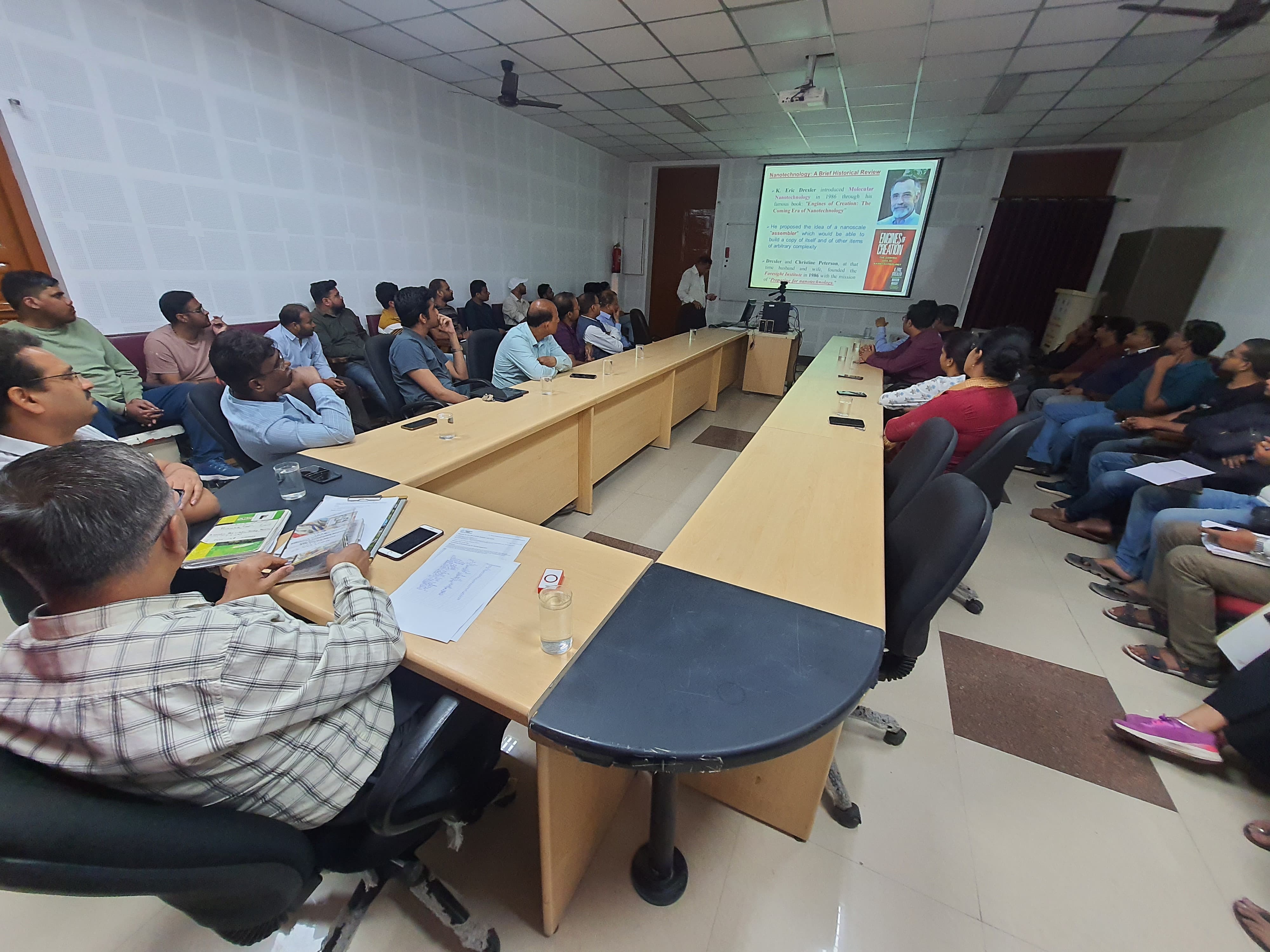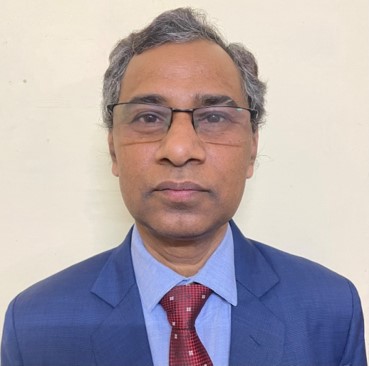Introduction to Nanomaterials for Sensing Applications
The event commenced with opening remarks by Dr. Manoj Kumar Meshram (Professor and HOD, Department of Electronics Engineering IIT-BHU), expressing gratitude to the speakers and attendees for their participation.
Professor Satyabrata Jit delivered a series of insightful presentations, generously sharing their extensive expertise and research findings. The presentation delved into the origins of nanotechnology, tracing its roots back to seminal works by Richard Feynman and the inception of the concept of "nanotechnology" in 1959. Prof. Jit elaborated on the evolution of nanomaterials, emphasizing natural nanostructures like the Brazilian crystal, Lycurgus cup, cytomegalovirus, viral capsid, peacock wing, butterfly wings, and others, which paved the way for ground-breaking advancements in materials science and nanotechnology. The talk covered different types of nanomaterials commonly used in sensing applications, including nanoparticles, nanowires, nanotubes, and 2D materials like graphene. Each type of nanomaterial possesses distinct properties that can be tailored for specific sensing requirements. Building upon this historical foundation, the talk transitioned to an exploration of the unique properties of nanomaterials that make them highly suitable for sensing applications. Jit explained how the fundamental characteristics of nanomaterials, including their high surface-to-volume ratio, quantum effects, and tunable properties, confer exceptional sensitivity and selectivity in sensing devices. Furthermore, Prof. Jit discussed various synthesis methods for producing nanomaterials, such as chemical vapour deposition, sol-gel, and self-assembly techniques. Understanding these methods is crucial for controlling the size, morphology, and composition of nanomaterials, which directly influence their sensing performance. Throughout the presentation, examples of nanomaterial-based sensors for environmental monitoring, healthcare diagnostics, and food safety applications were discussed, illustrating the wide-ranging potential of nanotechnology in sensing. Finally, the discussion emphasized the relevance of nanomaterials in developing sensing technology, as well as continuing research efforts targeted at enhancing the performance and scalability of nanomaterial-based sensors.
Date and Time
Location
Hosts
Registration
-
 Add Event to Calendar
Add Event to Calendar
- Committee Room
- IIT (BHU), Varanasi
- Varanasi, Uttar Pradesh
- India 221005
- Building: Department of Electronics Engineering
- Contact Event Host
- Co-sponsored by IETE Varanasi Sub-Centre, MTT-S, AP-S, AESS Student Branch Chapters and Department of Electronics Engineering, IIT(BHU), Varanasi, UP
- Survey: Fill out the survey
Speakers
Prof. Satyabrata Jit of IIT BHU, Varanasi
Introduction to Nanomaterials for Sensing Applications
Professor Satyabrata Jit delivered a series of insightful presentations, generously sharing their extensive expertise and research findings. The presentation delved into the origins of nanotechnology, tracing its roots back to seminal works by Richard Feynman and the inception of the concept of "nanotechnology" in 1959. Prof. Jit elaborated on the evolution of nanomaterials, emphasizing natural nanostructures like the Brazilian crystal, Lycurgus cup, cytomegalovirus, viral capsid, peacock wing, butterfly wings, and others, which paved the way for ground-breaking advancements in materials science and nanotechnology. The talk covered different types of nanomaterials commonly used in sensing applications, including nanoparticles, nanowires, nanotubes, and 2D materials like graphene. Each type of nanomaterial possesses distinct properties that can be tailored for specific sensing requirements. Building upon this historical foundation, the talk transitioned to an exploration of the unique properties of nanomaterials that make them highly suitable for sensing applications. Jit explained how the fundamental characteristics of nanomaterials, including their high surface-to-volume ratio, quantum effects, and tunable properties, confer exceptional sensitivity and selectivity in sensing devices. Furthermore, Prof. Jit discussed various synthesis methods for producing nanomaterials, such as chemical vapour deposition, sol-gel, and self-assembly techniques. Understanding these methods is crucial for controlling the size, morphology, and composition of nanomaterials, which directly influence their sensing performance. Throughout the presentation, examples of nanomaterial-based sensors for environmental monitoring, healthcare diagnostics, and food safety applications were discussed, illustrating the wide-ranging potential of nanotechnology in sensing. Finally, the discussion emphasized the relevance of nanomaterials in developing sensing technology, as well as continuing research efforts targeted at enhancing the performance and scalability of nanomaterial-based sensors.
Biography:
Prof. S. Jit has earned his B.E., M.Tech. and Ph.D. degrees from the IIEST Shibpore (formerly BE College affiliated to the University of Calcutta), West Bengal in 1993; Indian Institute of Technology Kanpur, India in 1995; and Indian Institute of Technology (BHU) (formerly IT-BHU)), Varanasi, India in 2002 respectively. He has worked as Lecturer at the Department of Electronics and Communication Engineering of the G.B. Pant Institute of Engineering and Technology (formerly G.B.Pant Engineering College), Pauri-Garhwal during June 1995-April 1998. He joined the Department of Electronics Engineering, IIT(BHU), Varanasi as Lecturer in April 1998 where he has been working as Professor since June 05, 2010 and Professor in HAG scale since June 05, 2016. Prof. Jit has served as the Coordinator/Director, Computer Center, BHU from February 2012 to March 2014 and Head, Department of Electronics Engineering, IIT(BHU), Varanasi during April 08, 2015-May 08, 2018. He has also served as the Chairperson, Senate Post Graduate Committee (SPGC) of the IIT(BHU) for 2013-14 & 2014-15 academic sessions. He has also served as a Member of the Board of Governors of the HBTI, Kanpur and UPTTI Kanpur for a period of 3 years each.
Prof. Jit has supervised 31 Ph.D. theses and has published more than 200 research papers in various peer reviewed international journals (including 75 IEEE publications). He has coauthored a text book titled Millman’s Electronic Devices and Circuits, 4/e published by the McGraw-Hill Publishing Company, New Delhi with Jacob Millman and Christos C. Halkias as other two coauthors. He is one of the Editors of three books titled Advanced Optoelectronic Materials and Devices and Emerging Trends in Electronic and Photonic Devices & Systems both published by the Macmillan Publishers India Limited, New Delhi in 2008 and 2009 respectively and Advances in Microelectronics and Photonics from Nova Science Publishers, New York, USA in 2012. Recently, he has published an edited volume titled 2D Nanoscale Heterostructured Materials published by the Elsevier in May, 2020. He has worked as one of the Guest Editors of the Special Issue on Narrow-Gap Semiconductors and Low-Dimensional Structures for Optoelectronic Applications (NAGAP) of the Scientific World Journal in 2014. His present research interests include the modeling and simulation of nanoscaled CMOS devices; nanostructured materials and devices for electronic, optoelectronic and gas sensing applications; Flexible Electronic Devices for Gas Sensing and Optoelectronic Applications, Solar Cells etc.
Prof. Jit has been elected as a Fellow of the West Bengal Academy of Science and Technology (WAST) in 2023. He is the recipient of the INSA (Indian National Science Academy) Visiting Fellowship in 2006. He has worked as Postdoctoral Research Fellow in the Optoelectronic Laboratory, Georgia State University, Atlanta, USA during March-August, 2007. He was awarded the BOYSCAST Fellowship of the Department of Science and Technology (DST), Govt. of India for the year 2010-11 to carry out some advance research in the Max-Born-Institute, Berlin, Germany during Sept.-Dec, 2011. Prof. Jit is a Fellow of the IET, UK; IETE, India; and Institution of Engineers India. He is a Senior Member of the IEEE, USA. At present, Prof. Jit is working as the Associate Editor of two journals namely IET Micro & Nano Letters (an IET Publication with IF: 0.975) and Journal of Electronic Materials (a Springer publication with IF: 2.047). He is also an Editor of the IETE Journal of Research ( a joint publication of IETE & Taylor and Francis with IF: 2.333).
Email:
Address:Department of Electronics Engineering, IIT (BHU), , Varanasi, India, 221005
Agenda
The IEEE technical talk on "Introduction to Nanomaterials for Sensing Applications" brought together researchers and engineers in the field of electronics. The event aimed to highlight the fundamental principles behind nanomaterial-based sensors, including the types of nanomaterials commonly used, their synthesis methods, and the mechanisms of sensing. Additionally, it will explore some key examples of nanomaterial-based sensors and highlight their potential advantages and challenges in sensing applications.
The event concluded with closing remarks from Dr. S. Bhattacharyya, expressing gratitude to the speakers and attendees for their contributions to the technical talk. In a fitting conclusion, we had the honour to have Dr. M. K. Meshram present a memento of appreciation to Dr. S. Jit.
Media
| talk report | 1.46 MiB |


